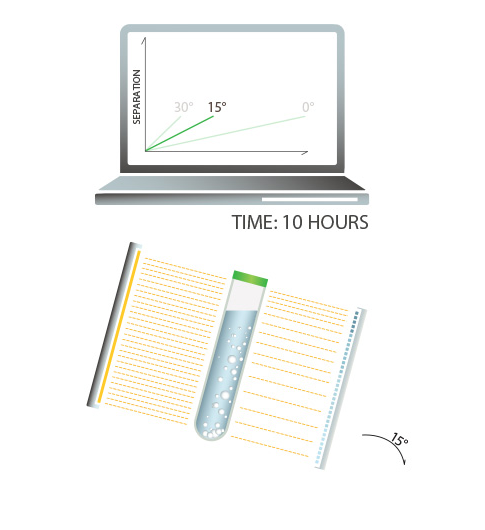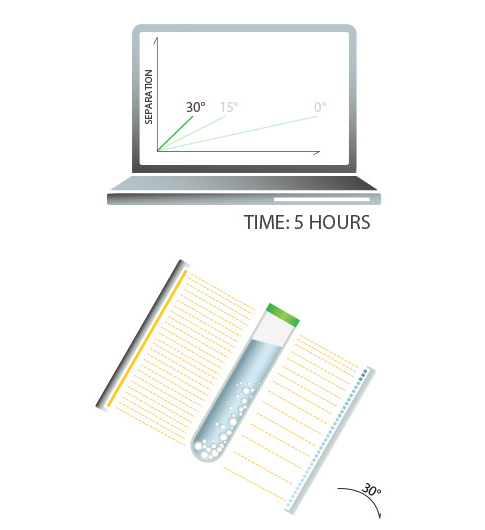- Home
- Technologies
- Sectors
- News
- About LUM
- Career
- Press releases
- Press reviews
- LUM Live
- Service
- Publications
- Contact
Die LUM Technologien
Unsere Technologien im Detail
The whole sample from top to bottom instantaneously
STEP-Technology®
At the heart of each instrument is the cutting-edge STEP-Technology, which is short for Space- and Time-resolved Extinction Profiles. It is the only technology that allows you to analyze your whole sample instantaneously from top to bottom.
Video examples
Polydisperse creaming profiles
Polydisperse sedimentation profiles
Up to 12 different samples
STEP-Technology® in detail
STEP-Technology permits to obtain Space- and Time-resolved Extinction Profiles over the entire sample length of up to 12 different samples simultaneously. Parallel light (I0) illuminates the entire sample cell and the transmitted light I is detected by thousands of sensors arranged linearly across your whole sample from top to bottom with a microscale resolution. Transmission is converted into extinction by lg I/I0 and particle concentration may be calculated. STEP-Technology gives also high flexibility to use different cells to match specific sample properties.
By means of the comprehensive software SEPView the light intensity can be adjusted to the corresponding sample turbidity. Transmission profils are recorded as fast as each second or with time intervalls up to hours, displayed as a sequence on the screen. Transmission date are automatically stored in a special designed database, together with all instrument settings and actual calibration data.
The speed of the centrifuge can be set at a constant value or programmed to change during the measurement in the range from 200 rpm to 4000 rpm. These rpm-values correspond to relative centrifugal forces (RCF) at the bottom of the cell of 5 to 2300 (RCF = centrifugal acceleration/earth gravity). Built-in temperature control covers all present and future applications.
Evaluation Features: The evolution of the transmission profiles contains the complete information on the kinetics of any concentration changes due to creaming, sedimentation, flocculation, coalescence or phase separation. Based on these space- and time-resolved extinction profiles demixing phenomena are quantified regarding clarification velocity, sedimentation and flotation velocity of particles, residual turbidity, separated phase volume (liquid or solid), sediment consolidation or dewaterability.
Furthermore, comprehensive infomation is obtained with respect to the multimodality or polydispersity of dispersed particles.
The decision is yours
Whether for research and development, quality control or product optimisation: with the LUMiSeries you are light years ahead of your competitors.
A new multi-sample absolute measurement technique
CAT-Technology
For materials testing, we have developed the Centrifugal Adhesion Testing-Technology for the comprehensive determination of adhesive, bonding and composite strength.
The principle of the new CAT-Technology is as simple as ingenious. Centrifugal force is applied to up to 8 sample assemblies. The load increase is programmed by variation of rotor rpm. If the applied load exceeds the tensile strength of the sample-assembly, the test stamp (TST) changes its position within a guiding sleeve.
The detachment of the TST (at the moment of rupture) is automatically detected and a position-coded IR-signal is send out of the turning rotor transmitting the current rotor speed as well as the rupture time. The force at rupture and the tensile strength, either bonding or adhesive strength, is calculated and displayed on-line by measurement software SEPView.
Advanced technology for effective sizing and
counting of single particles from nano- to microscale
SPLS-Technology®
Single Particle Light-Scattering Technology® (SPLS), a technology which records light that is scattered into into forward and sideward directions by single nano- and micro particles while passing a laser beam of a special beam cross-section. It is used in the LUMiSpoc® singe particle optical counter.
Single particles are lined up in a single line by hydro-dynamic focusing in an optical flow cell. This way, a sample flow in the middle and a surrounding sheath flow are created by means of pressure differences. The sheath flow creates a kind of fluid wall for the sample flow and prevents mechanical blockages. The cross section of the sample flow can be adjusted dynamically (by factor 35) with no changes to the mechanical parts.
This allows you to work in a wide sample concentration range. When a single particle crosses the laser beam, the light is scattered in all directions. Forward and sideward scattering of light are recorded simultaneously by means of two photomultipliers, and are analyzed in real-time after amplification and digitalization.
The scattered light intensities determined for each particle are sorted in more than 1 million bins and displayed as high-resolution bar-chart stating the count distribution on an easy-to-use touch screen. Classified intensities are converted into particle size distribution density based on the Mie theory.
Measurement, data storage and analysis are powered by software platform SEPView®.
SPLS-Technology® enables you to get a deep insight into complex nano- and submicro-particulate systems, which helps you to design tailored particles and dispersions.
Fast and accurate product property evaluation
MRS-Technology®
Each product shows distinct reflectances and scatterings for the applied incident light spectrum. It has its own optical fingerprint dependent on the sample composition (constituents, concentration).
Basic scheme
Incident light (1) from a multiwavelength source (LS) illuminates a small or large volume of interest of the sample. Received scattered light intensities (2, 3) from different sample regions are recorded by differently localized detectors (D) to characterize the product. Reflectance intensities at upper and lower part of sensor window (4, 5) are utilized as references.
The optical fingerprint
MRS-Technology® in detail
The MRS-Technology® (Multi Reflectance Spectroscopy) quantifies these fingerprints by illuminating the sample through an optical window at different wavelengths and detecting/recording for each wavelength several reflected product specific intensities. It is used in the LUMiFlector® product parameter and process control instrument.
Incident light of multiple wavelengths (> 20) in the range of UV-VIS-NIR (can be customized) is transmitted through optical fibers and the optical window into the sample. Receivers are positioned in a way that they get the reflected and scattered signals originating from different regions of sample in one short measurement.
In this manner, linear scattered (small volume of interest, see scheme), saturated scattered (large volume of interest, see scheme) as well as the refracted light intensities are obtained. These comprehensive data allow to determine the specific optical properties of the given product.
Even more, product parameters like fat or protein content are calculated automatically by the instrument based on product specific pre-calibration using multivariate statistical methods (multi linear regression). So MRS-Technology® is very flexible and can be adopted for many application fields. Parameters for process control and QC can be determined in less than 20 seconds.
Individual advice is important to us
We will be happy to advise you on our equipment, processes and technologies.
LUM News
Jobs, Reports & Events






